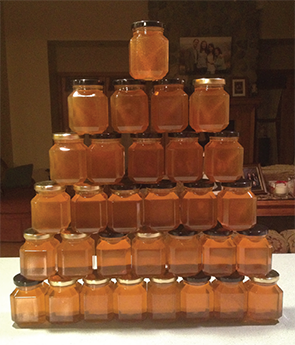
Dr. Ritchlin and his daughter, Christina, who shares his love of beekeeping.
When Christopher Ritchlin, MD, MPH, isn’t teaching students, residents and fellows at the University of Rochester Medical Center (URMC), treating patients or conducting medical research in his lab, he’s monitoring the health of another sort of patient—honeybees.
For the past four years. Dr. Ritchlin, professor and chief of allergy, immunology and rheumatology at URMC, has been a year-round beekeeper. He considers the duties of beekeeping akin to that of a physician: both involve a sensitive balancing act. Considering the unusual decline in honeybee colonies over the past 20 years, he is helping restore some of their population so they can continue pollinating approximately one-third of the world’s vegetables and fruits and converting the nectar they collect into honey.
“I’ve always been interested in honeybee behavior and the biology of honeybees and their social structure,” says Dr. Ritchlin, adding that beekeeping provides him with an opportunity to interface with one of the most organized species on the planet.
Nature’s Way
Dr. Ritchlin completed medical school at Albany Medical College in 1982. He spent the next four years working on his residency and chief residency in internal medicine at Mt. Sinai Hospital in Manhattan. From 1986–1990, he completed his fellowship at New York University, training in rheumatology and research, and he spent another year conducting lab research with Robin Poole, PhD, in Montreal.
He started his teaching and research career at the University of Rochester in 1991, and in 2007, he obtained a master’s degree in public health at the same institution. He focused on molecular biology, researching the relationship between gene activation and joint inflammation.
“The MPH allowed me to concentrate on how to really look at patient-oriented research using clinical trials, as well as observational studies, and add that to what we were already doing,” says Dr. Ritchlin.

Dr. Ritchlin, smoking one of his hives. The smoke calms the bees and creates an opportunity for the beekeeper to open the beehive and work while the colony’s defensive response is interrupted.
Although his fascination for honeybees began after he enrolled in an undergraduate animal behavior course at the University of Rochester, completing his medical education, treating patients, conducting medical research and raising a family occupied the majority of his time. It wasn’t until 2011—more than three decades after taking that course—that he began reading books about raising bees, completed an eight-week beginner bee course sponsored by the Ontario Finger Lakes Beekeepers Association and attended the organization’s monthly meetings.
He was hooked. The following spring, he purchased a bee suit, some basic tools and a Langstroth beehive, which is named after the father of American beekeeping—Reverend Lorenzo Lorraine Langstroth. The hive is made up of stacked boxes containing eight wooden frames in which bees build their comb, lay their eggs and make honey. He says his initial investment was less than $600.
Unlike a queen bee, which can live three to five years, worker bees live only about 40 days. The queen lays 2,000 eggs a day—or about 1 million during her lifetime. Worker bees perform specific duties at various ages. Young bees clean up the hive, for example, while older bees take care of the queen bee, search for pollen or serve as guard bees, he explains.
Unfortunately, bees can’t survive harsh winters. But temperatures during the past two years were warmer than usual and his bees thrived, making lots of honey. This past year, he and Christina, his 23-year-old daughter who shares his love of beekeeping, bottled 88 jars of honey as gifts for family and friends.
“When we give away the honey, people just go crazy,” he says, explaining that many different wildflowers like clover and goldenrod grow on 65 acres surrounding his home, which is in the Finger Lakes region in upstate New York, a big honeybee area for apiaries. “We really have delicious honey. It’s got a really distinct taste.”
Overlapping Skills

Last year, Dr. Ritchlin and his daughter bottled 88 jars of honey for family and friends.
Dr. Ritchlin’s home sits on five acres and houses a large vegetable garden in the backyard that consists of lettuce, peppers, tomatoes and other crops. He says the pollination from his honeybees has been “quite dramatic” in terms of their healthy size and quality.
He believes beekeeping is an ideal hobby for physicians because it’s not intensely time consuming and really helps the environment.
“All doctors have a scientific background so they understand the scientific and ecological elements of this, which is really important, says Dr. Ritchlin. “It’s critical that we bring back the pollinators and also become politically involved in limiting the toxins in the environment that are killing the pollinators.”
He explains that pesticides and fertilizers are deadly for bees and among the major reasons for the decimation of their population.
“We really need pollinators for the majority of our crops,” Dr. Ritchlin says. “This is a real problem. We need to come to grips with it.”
Meanwhile, he says part of being a physician involves being observant of patients, actually developing a sense about them and the world in which they live. Likewise,
beekeeping also provides him with an awareness of the natural world around him.
“It’s given me a whole new awareness in a different dimension,” he says, explaining that he pays full attention to the weather, climate trends and which flowers or trees are blossoming. “Beekeeping allows me to use the skills that I use in medicine, which is the same awareness of what’s going on with my patients.”
Listen to Dr. Ritchlin talk about beekeeping and how it relates to rheumatology.
Carol Patton is a freelance writer based in Las Vegas.
